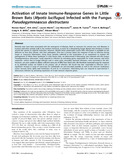| dc.contributor.author | Rapin, Noreen | |
| dc.contributor.author | Johns, Kirk | |
| dc.contributor.author | Martin, Lauren | |
| dc.contributor.author | Warnecke, Lisa | |
| dc.contributor.author | Turner, James M. | |
| dc.contributor.author | Bollinger, Trent K. | |
| dc.contributor.author | Willis, Craig K. R. | |
| dc.contributor.author | Voyles, Jamie | |
| dc.contributor.author | Misra, Vikram | |
| dc.date.accessioned | 2016-11-17T21:30:28Z | |
| dc.date.available | 2016-11-17T21:30:28Z | |
| dc.date.issued | 2014-11-12 | |
| dc.identifier.citation | Rapin, N., K. Johns, L. Martin, L. Warnecke, J. M. Turner, et al. "Activation of Innate Immune-Response Genes in Little Brown Bats (Myotis lucifugus) Infected with the Fungus Pseudogymnoascus destructans." PLoS ONE 9(11) (2014): e112285. DOI: 10.1371/journal.pone.0112285. | en_US |
| dc.identifier.issn | 1932-6203 | |
| dc.identifier.uri | http://hdl.handle.net/10680/1248 | |
| dc.description.abstract | Recently bats have been associated with the emergence of diseases, both as reservoirs for several new viral diseases in humans and other animals and, in the northern Americas, as hosts for a devastating fungal disease that threatens to drive several bat species to regional extinction. However, despite these catastrophic events little Information is available on bat
defences or how they interact with their pathogens. Even less is known about the response of bats to infection during torpor or long-term hibernation. Using tissue samples collected at the termination of an experiment to explore the pathogenesis of White Nose Syndrome in Little Brown Bats, we determined if hibernating bats infected with the fungus Pseudogymnoascus destructans could respond to infection by activating genes responsible for innate immune and stress responses. Lesions due to fungal infection and, in some cases, secondary bacterial infections, were restricted to the skin. However, we were unable to obtain sufficient amounts of RNA from these sites. We therefore examined lungs for response at an epithelial surface not linked to the primary site of infection. We found that bats responded to infection with a significant increase in lungs of transcripts for Cathelicidin (an anti-microbial peptide) as well as the immune modulators tumor necrosis factor alpha and interleukins 10 and 23. In conclusion, hibernating bats can respond to experimental P.
destructans infection by activating expression of innate immune response genes. | en_US |
| dc.description.sponsorship | Funding for this study was provided by a Fish and Wildlife Service grant to CRKW, TB and VM and by a Natural Sciences and Engineering Research Council (Discovery) grant to VM and a fellowship within the Postdoc Programme of the DAAD, German Academic Exchange Service (to LW). The funders had no role in study design, data collection and analysis, decision to publish or preparation of the manuscript. | en_US |
| dc.description.uri | https://journals.plos.org/plosone/article?id=10.1371/journal.pone.0112285 | |
| dc.language.iso | en | en_US |
| dc.publisher | PLoS ONE | en_US |
| dc.rights | info:eu-repo/semantics/openAccess | |
| dc.subject | Little Brown Bat | en_US |
| dc.subject | Immune-response Genes | en_US |
| dc.title | Activation of Innate Immune-Response Genes in Little Brown Bats (Myotis lucifugus) Infected with the Fungus Pseudogymnoascus destructans | en_US |
| dc.type | Article | en_US |
| dc.rights.license | 2014 Rapin et al. This is an open-access article distributed under the terms of the Creative Commons Attribution License, which permits unrestricted use, distribution, and reproduction in any medium, provided the original author and source are credited. | |
| dc.identifier.doi | 10.1371/journal.pone.0112285 | |

